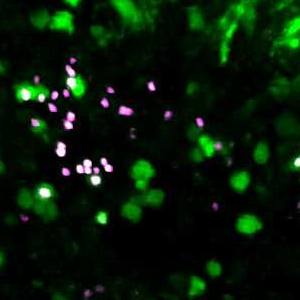-
After 40 Years, HIV Presents Research Problems New and Old
In the years since AIDS was first described in medical research, the scientific map of that disease has changed enormously. Once it was relatively empty. Now scientists, clinicians and patients have toiled to fill in the diagnostic pathways, treatment landmarks and prevention guideposts.
Among them is HIV clinician-researcher Stacey Rizza, M.D., a Mayo Clinic infectious diseases physician. In a Q&A interview with the Mayo Clinic News Network, Dr. Rizza explained why AIDS continues to be an epidemic. From the way HIV slips into the genome and hides in immune tissue, to the new protocols for drawing the virus out so it can be eliminated, Dr. Rizza lays out the broad strokes of HIV research.
But Dr. Rizza, who collaborates with Mayo Clinic researchers on HIV, also has examined how research and clinical care must pivot to address the remaining challenges and new ones related to aging that a growing number of patients with HIV now face.
The HIV Research Map, Then
The spotlight of research fell on the AIDS epidemic, not at the start, but on the disease as it began to spread widely in humans. Global cases retroactively linked to HIV infection show that the virus's ancestry in humans may date back over 100 years. But the start of widespread HIV infection in the U.S. generally dates to a report in 1981 on five cases of pneumonia.

Caused by Pneumocystis carinii, this type of pneumonia was rare, except among patients with severe immune system suppression. Finding this as the cause of death in five healthy young men was unusual, the authors wrote. By 1984, researchers had established a link between sexual contact and AIDS, but they didn't know the cause. During the decade, misinformation and discrimination affected people diagnosed with AIDS, especially gay men. In 1985, a blood test for AIDS was approved, and in 1986, scientists identified HIV as the cause of AIDS.
By 1987, the profile of a person at risk of contracting AIDS was starting to broaden. Ryan White, a child who contracted HIV during a blood transfusion, was on the cover of People Weekly. The story depicted a day in the life of Americans, including White, who contracted or were at risk of contracting HIV through sex or contact with blood, including through birth or as part of their job. It also showcased worries the public had about HIV, namely mosquitoes, public pools and touching dried blood on a chair — none of which, the article clarified — are risks. That year, the first drug ― tested initially as a cancer treatment ― was approved to treat HIV infection. It marked a blossoming of treatment advances that have continued for people infected with HIV.

"We've gone from people taking multiple medicines with lots of side effects to the majority of my patients with HIV now taking a single pill a day that's extremely well-tolerated and completely suppresses their virus," says Dr. Rizza. "We now have a handful of people in the world who have been what we called functionally cured of HIV, meaning they've gone through some research protocols that eliminate the reservoir of HIV in their body. And if they stop the HIV medicines, the virus doesn't come back. So if you had told me even 20 years ago this would ever happen, I would have been shocked. The fact we're now in a world that people take a single pill a day and people are being cured of HIV is just remarkable."
The HIV Research Map, Today
In terms of treatment, scientists are still adding to the map. By understanding the structure and life cycle of HIV, researchers are working on new ways of flushing the virus from its hiding place and then eliminating it. The lab of Andrew Badley, M.D., a Mayo Clinic infectious diseases specialist, has two projects that take this approach. Dr. Rizza collaborates with Dr. Badley.
The first project involves a protein on the surface of T cells. Called TRAIL, this protein normally controls whether a cell lives or dies. The team discovered that cells from patients with HIV infection make a unique form of TRAIL, which they call TRAILshort. It is an altered version of the protein that causes infected T cells to resist death, and it can be shared within the cell's neighborhood via extracellular vesicles. This promotes the survival of HIV infected cells.
The long-term goal of Dr. Badley's TRAILshort project is to block the function of TRAILshort and allow HIV infected cells to die and be eliminated. Not only is this finding leading to new HIV treatment approaches, but also Dr. Badley and his lab are expanding this finding into a potential treatment for cancer.

"Our lab has spent decades understanding how and why some cells which are infected with HIV die, but others do not," says Dr. Badley. "That understanding has enabled us to test ways of making all cells which are infected with HIV die from the infection. If successful, we will have changed HIV infection in the test tube from an infection which persists into one that is short-lived ― analogous to influenza infection. We are hopeful that our findings will translate in human studies which are underway, and that the results will contribute to a cure for HIV-infected patients."
The second project focuses on the T cells where HIV hides. Because HIV kills only a few of the cells it infects, the virus can hide from treatment.
Over the past 20 years, Dr. Badley's lab has studied the biochemical signals that cause infected cells to die and focused on a crucial protein for cell death called Casp8p41. They also investigated the cells that do not die, and they discovered that Casp8p41 is still produced but blocked in survivor cells. The lab is testing drugs that boost the level of Casp8p41 or enhance its ability to kill infected cells to see if they can clear out this HIV reservoir. Working with collaborators, Dr. Badley and team have just completed a small phase 1 clinical trial to test their approach. Dr. Rizza, who collaborates with Dr. Badley on Casp8p41 research, thinks this approach is a promising pathway to follow.
"This new science is exciting. It's getting closer and closer to understanding how to do this effectively," Dr. Rizza says. "And if you can do that with oral medications rather than fancy therapies like gene therapy or bone marrow transplant, it's scalable to large parts of the world, and you can touch millions of people that way."

New Challenges
The fact that some patients have been functionally cured while others are living with HIV as a chronic illness is unquestionably a win for patients and medical research. But it brings with it a new medical wrinkle. As people are living with HIV, they are — happily — aging. With advancing age comes a host of illnesses that physicians will need to understand in the context of HIV as a chronic illness.
"The fact that we are talking about HIV and aging is, by itself, a huge achievement," says Zelalem Temesgen, M.D., a Mayo infectious diseases specialist. "The number of older people living with HIV is growing. According to the CDC, 51% of the people in the United States and dependent areas living with HIV in 2018 were aged 50 and older. The proportion of the global adult population living with HIV that is aged 50 years and older is projected to be over 20%."
Dr. Temesgen says people aging with HIV share the same health concerns as the general population of similar age, but also have to contend with the additional burden of complications that HIV predisposes them to, despite the lauded success of anti-retroviral therapy. As research continues to understand the full impact of HIV on the aging process, clinicians need to prepare themselves to provide comprehensive and holistic care to their aging patients living with HIV.

But are clinicians ready for that?
Some are, but some are not, according to research published in January from Mayo clinician-researchers. Led by Dr. Temesgen as senior author the team, including Dr. Rizza, conducted a national survey of U.S. providers. They wanted to assess if clinicians felt they were ready to manage the needs of aging patients living with HIV.
In 2018, they surveyed HIV providers collected from a trade association and hospital sources. They report in a study published in January that of 226 participants, only about half of the respondents felt prepared to care for this category of patients as they age. Within the responses, HIV providers expressed interest specifically in knowing more about screening for age-related diseases, heart disease, neuro-cognitive disorders, and palliative care in the context of their patients with HIV. The authors concluded that geriatric medicine, one of the least popular specialties among new doctors, would be a key area for HIV providers, and one that required attention, standardization and expansion.
And, of course, in addition to improved treatment and education, the goals of curative treatment for all and a vaccine remain.
"The last major hurdle we have is to develop an effective vaccine," says Dr. Rizza. "We still don't have a vaccine that can prevent infection or a therapeutic vaccine, where you give it to people who already have the virus that can help them fight the infection."
- Sara Tiner







